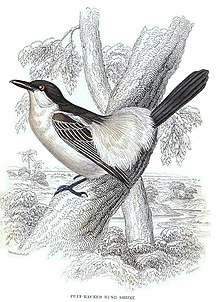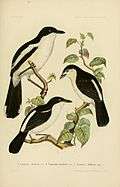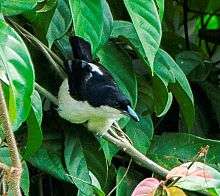Dryoscopus
Dryoscopus is a genus of bird in the Malaconotidae or bushshrike family. The six species of fairly uniform appearance and habits, are all native to various parts of sub-Saharan Africa.[1] The name Dryoscopus is a compound Greek word: drus from the Greek word for "tree" and skopos, meaning "watcher or lookout".[2]
| Dryoscopus | |
|---|---|
 | |
| Displaying D. gambensis male | |
| Scientific classification | |
| Kingdom: | Animalia |
| Phylum: | Chordata |
| Class: | Aves |
| Order: | Passeriformes |
| Family: | Malaconotidae |
| Genus: | Dryoscopus F. Boie, 1826 |
Structure and habits
They are small, active bushshrikes that show a superficial resemblance to boubous. They however display only rudimentary duetting, have red or reddish irides, are smaller and compact with bouncy flight, and display sexual dimorphism.[3] Characteristically, the long, loose and pale feathers of the male bird's back and rump are puffed out conspicuously during display. At the same time he may fly about, calling loudly.[4] Comparable habits are found in some related genera (cf. Bocagia, Bias, Lanioturdus, Batis and Dyaphorophyia).[5]

They move about in pairs in the upper strata of trees (Pringle's excepting) and may join mixed-species flocks.[4] They command a varied repertoire of explosive and fricative whistles, percussive clicking sounds, and harsh rasping, churring or tearing sounds.[5] Three species have a rasping alarm call (cubla, senegalensis and pringlii), while the remaining three (gambensis, angolensis and sabini) have a stuttering alarm call. Wing fripping and bill snapping complement vocal communication. The nest is a neat compact cup in the general fashion of bushshrikes, but similar to those of shrike-flycatchers. Courtship feeding is present, and studied species are monogamous and single-brooded.
Relationships
DNA-DNA hybridization studies suggest that genus Tchagra is their closest relative, though biological traits also link them to Laniarius, shrike-flycatchers (i.e. Bias and Megabyas) and other genera.[5]
Species
The genus contains the following six species:[6]
| Image | Common Name | Scientific name | Habitat | Distribution |
|---|---|---|---|---|
 | Pink-footed puffback | Dryoscopus angolensis | isolated montane and submontane forests | Kenya, Uganda and the eastern Congo Basin |
 | Black-backed puffback | Dryoscopus cubla | tropical to austral woodlands and afromontane forest | sub-Saharan Africa, from southern Somalia to coastal South Africa. |
%2C_crop.jpg) | Northern puffback | Dryoscopus gambensis | equatorial to sub-Saharan wooded savannah | equatorial and southern Africa |
| Pringle's puffback | Dryoscopus pringlii | dry, equatorial acacia scrub and thicket | Ethiopia, Kenya, Somalia, and northern Tanzania | |
 | Sabine's puffback | Dryoscopus sabini | tropical forest | Congo basin and West African coast |
| Red-eyed puffback | Dryoscopus senegalensis | mid-canopy at tropical forest edge and clearings[3] | Nigeria and Central Africa. | |
Gallery
_(6017632158).jpg) Head of male, D. cubla, showing red iris
Head of male, D. cubla, showing red iris_(31638418377)%2C_crop.jpg) Displaying male, D. cubla, with raised back and rump feathers
Displaying male, D. cubla, with raised back and rump feathers_male_(32397227986).jpg) Tit-like foraging habit of male D. cubla
Tit-like foraging habit of male D. cubla_(14749479424).jpg) Nest of D. cubla wedged in branches of a sapling
Nest of D. cubla wedged in branches of a sapling
References
- Monroe, Jr., Burt L.; Sibley, Charles G. (1997). A World Checklist of Birds. New Haven, CT, USA: Yale University Press. pp. 213–4. ISBN 978-0-300-07083-5.
- Jobling, James A. (2010). The Helm Dictionary of Scientific Names. London, UK: Christopher Helm. p. 141. ISBN 978-1-4081-2501-4.
- Sinclair, Ian; Ryan, Peter (2010). Birds of Africa south of the Sahara (2nd ed.). Cape Town: Struik Nature. pp. 580–581. ISBN 9781770076235.
- Terry Stevenson; John Fanshawe (2004). Birds of East Africa: Kenya, Tanzania, Uganda, Rwanda, Burundi. Helm Field Guides. p. 472. ISBN 0713673478.
- Harris, Tony; Franklin, Kim (2000). Shrikes & bush-shrikes: including wood-shrikes, helmet-shrikes, flycatcher-shrikes, philentomas, batises and wattle-eyes. London: C. Helm. pp. 35–46. ISBN 9780713638615.
- "ITIS Report: Dryoscopus". Integrated Taxonomic Information System. Retrieved 20 October 2014.